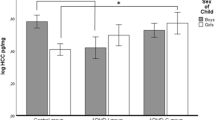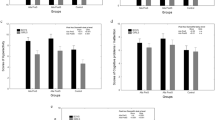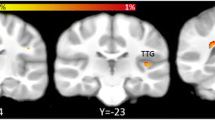Abstract
Previous studies suggest a different regulation of the hypothalamus–pituitary–adrenal axis (HPA-axis) with lower diurnal cortisol levels, especially in the morning, in children with attention-deficit/hyperactivity disorder (ADHD) compared with controls. Since exposure to foetal and childhood psychosocial adversity has been associated with both ADHD and HPA-axis functioning, such exposures may explain these low cortisol levels in ADHD via early programming of the HPA-axis. Thus, our main aim was to retrospectively study foetal and early childhood exposures to psychosocial adversity in children with ADHD and to relate these exposures to cortisol levels. Saliva samples were collected during a regular weekday in children, 6–17 years old, with clinically confirmed ADHD (n = 197) and non-affected comparisons (n = 221) for radioimmunoassay analysis of cortisol. Parental rating scales were used for categorising subtypes of ADHD and degree of exposure to adversity. Children with ADHD had more reports of at least one rated foetal adversity (p = 0.041) and childhood adversity (p < 0.001) than comparisons. The association between low morning cortisol levels and ADHD-symptoms remained when analyses were adjusted for adversities, age, sex, sampling time and symptoms of oppositional defiant disorder. No relation was found between exposures to foetal/childhood adversity and cortisol levels except for a positive relation between childhood adversity and cortisol morning increase in children with ADHD. The hypothesis that early adversity may influence the HPA-axis, leading to lower cortisol levels in children with ADHD, was not supported by our findings.
Similar content being viewed by others
References
King JA, Barkley RA, Barrett S (1998) Attention-deficit hyperactivity disorder and the stress response. Biol Psychiatry 44(1):72–74
Blomqvist M, Holmberg K, Lindblad F, Fernell E, Ek U, Dahllof G (2007) Salivary cortisol levels and dental anxiety in children with attention deficit hyperactivity disorder. Eur J Oral Sci 115(1):1–6
Ma L, Chen YH, Chen H, Liu YY, Wang YX (2011) The function of hypothalamus–pituitary–adrenal axis in children with ADHD. Brain Res 1368:159–162
Isaksson J, Nilsson KW, Nyberg F, Hogmark A, Lindblad F (2012) Cortisol levels in children with attention-deficit/hyperactivity disorder. J Psychiatr Res 46:1398–1405
Bartels M, de Geus EJ, Kirschbaum C, Sluyter F, Boomsma DI (2003) Heritability of daytime cortisol levels in children. Behav Genet 33(4):421–433
Biederman J, Faraone SV (2005) Attention-deficit hyperactivity disorder. Lancet 366(9481):237–248
Thapar A, Cooper M, Jefferies R, Stergiakouli E (2012) What causes attention deficit hyperactivity disorder? In: Archives of disease in childhood, vol 97. vol 3. England, pp 260–265
Banerjee TD, Middleton F, Faraone SV (2007) Environmental risk factors for attention-deficit hyperactivity disorder. Acta Paediatr 96(9):1269–1274
Maccari S, Morley-Fletcher S (2007) Effects of prenatal restraint stress on the hypothalamus–pituitary–adrenal axis and related behavioural and neurobiological alterations. Psychoneuroendocrinology 32(Suppl 1):S10–S15
Van den Bergh BR, Marcoen A (2004) High antenatal maternal anxiety is related to ADHD symptoms, externalizing problems, and anxiety in 8- and 9-year-olds. Child Dev 75(4):1085–1097
Rodriguez A, Bohlin G (2005) Are maternal smoking and stress during pregnancy related to ADHD symptoms in children? J Child Psychol Psychiatry 46(3):246–254
Talge NM, Neal C, Glover V (2007) Antenatal maternal stress and long-term effects on child neurodevelopment: how and why? J Child Psychol Psychiatry 48(3–4):245–261
Hjern A, Weitoft GR, Lindblad F (2010) Social adversity predicts ADHD-medication in school children—a national cohort study. Acta Paediatr 99(6):920–924
Lupien SJ, King S, Meaney MJ, McEwen BS (2000) Child’s stress hormone levels correlate with mother’s socioeconomic status and depressive state. Biol Psychiatry 48(10):976–980
Cicchetti D, Rogosch FA (2001) Diverse patterns of neuroendocrine activity in maltreated children. Dev Psychopathol 13(3):677–693
O’Connor TG, Ben-Shlomo Y, Heron J, Golding J, Adams D, Glover V (2005) Prenatal anxiety predicts individual differences in cortisol in pre-adolescent children. Biol Psychiatry 58(3):211–217
Gunnar MR, Frenn K, Wewerka SS, Van Ryzin MJ (2009) Moderate versus severe early life stress: associations with stress reactivity and regulation in 10–12-year-old children. Psychoneuroendocrinology 34(1):62–75
Carlson M, Earls F (1997) Psychological and neuroendocrinological sequelae of early social deprivation in institutionalized children in Romania. Ann N Y Acad Sci 807:419–428
Gunnar MR, Vazquez DM (2001) Low cortisol and a flattening of expected daytime rhythm: potential indices of risk in human development. Dev Psychopathol 13(3):515–538
Yehuda R, Engel SM, Brand SR, Seckl J, Marcus SM, Berkowitz GS (2005) Transgenerational effects of posttraumatic stress disorder in babies of mothers exposed to the World Trade Center attacks during pregnancy. J Clin Endocrinol Metabol 90(7):4115–4118
Bruce J, Fisher PA, Pears KC, Levine S (2009) Morning cortisol Levels in preschool-aged foster children: differential effects of maltreatment type. Dev Psychobiol 51(1):14–23
Gunnar MR, Quevedo KM (2008) Early care experiences and HPA axis regulation in children: a mechanism for later trauma vulnerability. In: Progress in brain research, vol 167. Netherlands, pp 137–149
Teicher MH, Andersen SL, Polcari A, Anderson CM, Navalta CP (2002) Developmental neurobiology of childhood stress and trauma. Psychiatr Clin N Am 25 (2):397–426, vii–viii
Lupien SJ, McEwen BS, Gunnar MR, Heim C (2009) Effects of stress throughout the lifespan on the brain, behaviour and cognition. Nat Rev Neurosci 10(6):434–445
Egliston KA, McMahon C, Austin MP (2007) Stress in pregnancy and infant HPA axis function: conceptual and methodological issues relating to the use of salivary cortisol as an outcome measure. Psychoneuroendocrinology 32(1):1–13
Kapoor A, Petropoulos S, Matthews SG (2008) Fetal programming of hypothalamic–pituitary–adrenal (HPA) axis function and behavior by synthetic glucocorticoids. Brain Res Rev 57(2):586–595
Van Voorhees E, Scarpa A (2004) The effects of child maltreatment on the hypothalamic–pituitary–adrenal axis. Trauma Violence Abuse 5(4):333–352
Rosengren A, Orth-Gomer K, Wedel H, Wilhelmsen L (1933) Stressful life events, social support, and mortality in men born in 1933. BMJ 307(6912):1102–1105
Rodriguez A, Waldenstrom U (2008) Fetal origins of child non-right-handedness and mental health. J Child Psychol Psychiatry 49(9):967–976
Bremner JD, Bolus R, Mayer EA (2007) Psychometric properties of the early trauma inventory-self report. J Nerv Ment Dis 195(3):211–218
Plaza A, Torres A, Martin-Santos R, Gelabert E, Imaz ML, Navarro P, Bremner JD, Valdes M, Garcia-Esteve L (2011) Validation and test-retest reliability of early trauma inventory in Spanish postpartum women. J Nerv Ment Dis 199(4):280–285
Swanson JM, Kraemer HC, Hinshaw SP, Arnold LE, Conners CK, Abikoff HB, Clevenger W, Davies M, Elliott GR, Greenhill LL, Hechtman L, Hoza B, Jensen PS, March JS, Newcorn JH, Owens EB, Pelham WE, Schiller E, Severe JB, Simpson S, Vitiello B, Wells K, Wigal T, Wu M (2001) Clinical relevance of the primary findings of the MTA: success rates based on severity of ADHD and ODD symptoms at the end of treatment. J Am Acad Child Adolesc Psychiatry 40(2):168–179
Bussing R, Fernandez M, Harwood M, Wei H, Garvan CW, Eyberg SM, Swanson JM (2008) Parent and teacher SNAP-IV ratings of attention deficit hyperactivity disorder symptoms: psychometric properties and normative ratings from a school district sample. Assessment 15(3):317–328
Hansen AM, Garde AH, Christensen JM, Eller NH, Netterstrom B (2003) Evaluation of a radioimmunoassay and establishment of a reference interval for salivary cortisol in healthy subjects in Denmark. Scand J Clin Lab Invest 63(4):303–310
Clow A, Hucklebridge F, Thorn L (2010) The cortisol awakening response in context. In: International review of neurobiology, vol 93. Elsevier Inc, United States, pp 153–175
Fries E, Dettenborn L, Kirschbaum C (2009) The cortisol awakening response (CAR): facts and future directions. Int J Psychophysiol 72:67–73
Deater-Deckard K, Dodge KA, Bates JE, Pettit GS (1998) Multiple risk factors in the development of externalizing behavior problems: group and individual differences. Dev Psychopathol 10(3):469–493
Hawes DJ, Brennan J, Dadds MR (2009) Cortisol, callous-unemotional traits, and pathways to antisocial behavior. Curr Opin Psychiatry 22(4):357–362
Murray-Close D, Han G, Cicchetti D, Crick NR, Rogosch FA (2008) Neuroendocrine regulation and physical and relational aggression: the moderating roles of child maltreatment and gender. Dev Psychol 44(4):1160–1176
Fairchild G (2010) Hypothalamic–pituitary–adrenocortical axis function in attention-deficit hyperactivity disorder. behavioral neuroscience of attention deficit hyperactivity disorder and its treatment, current topics in behavioral neuroscience 9. Springer Verlag, Berlin, pp 93–111
Sarkar P, Bergman K, O’Connor TG, Glover V (2008) Maternal antenatal anxiety and amniotic fluid cortisol and testosterone: possible implications for foetal programming. J Neuroendocrinol 20(4):489–496
Bergman K, Sarkar P, Glover V, O’Connor TG (2010) Maternal prenatal cortisol and infant cognitive development: moderation by infant–mother attachment. Biol Psychiatry 67(11):1026–1032
O’Connor TG, Bergman K, Sarkar P, Glover V (2012) Prenatal cortisol exposure predicts infant cortisol response to acute stress. Dev Psychobiol. doi:10.1002/dev.21007
Liu J, Raine A, Venables PH, Mednick SA (2004) Malnutrition at age 3 years and externalizing behavior problems at ages 8, 11, and 17 years. Am J Psychiatry 161(11):2005–2013
Rice F, Harold GT, Boivin J, van den Bree M, Hay DF, Thapar A (2010) The links between prenatal stress and offspring development and psychopathology: disentangling environmental and inherited influences. Psychol Med 40(2):335–345
Infante-Rivard C, Jacques L (2000) Empirical study of parental recall bias. Am J Epidemiol 152(5):480–486
Greenwald R, Rubin A (1999) Assessment of posttraumatic symptoms in children: development and preliminary validation of parent and child scales. Res Social Work Prac 9:61–75
Coddington RD (1972) The significance of life events as etiologic factors in the disease of children. J Psychosom Res 16:7–18
Schlotz W, Hellhammer J, Schulz P, Stone AA (2004) Perceived work overload and chronic worrying predict weekend–weekday differences in the cortisol awakening response. Psychosom Med 66(2):207–214
Perneger TV (1998) What’s wrong with Bonferroni adjustments. BMJ 316(7139):1236–1238
Acknowledgments
We are grateful to all children who volunteered and to their parents and schools in Uppsala, Enköping and Gävle who made it possible for us to recruit the children. We are also grateful to the child and adolescent Psychiatric units in Uppsala, Enköping, Gävle and Falun for contributions to the recruitment procedure. We also want to thank Hans Arinell for statistical assistance and Lars Holmberg for the cortisol analyses. The study was supported by Grants from Victoriafonden through the Swedish Brain Foundation, (Hjärnfonden), (no specific grant no.). The PhD position of Johan Isaksson was supported by Uppsala University Hospital Research Fund (ALF), (no specific grant no.). The research position of Frank Lindblad was financed by the Swedish Council for Working Life and Social Research, Grant No. 2006-0197.
Conflict of interest
The authors declare that they have no conflicts of interest.
Author information
Authors and Affiliations
Corresponding author
Rights and permissions
About this article
Cite this article
Isaksson, J., Nilsson, K.W. & Lindblad, F. Early psychosocial adversity and cortisol levels in children with attention-deficit/hyperactivity disorder. Eur Child Adolesc Psychiatry 22, 425–432 (2013). https://doi.org/10.1007/s00787-013-0383-0
Received:
Accepted:
Published:
Issue Date:
DOI: https://doi.org/10.1007/s00787-013-0383-0




